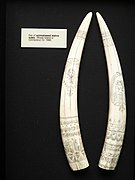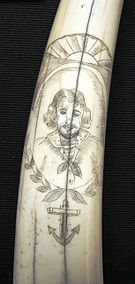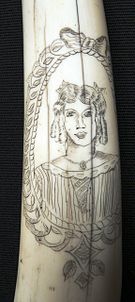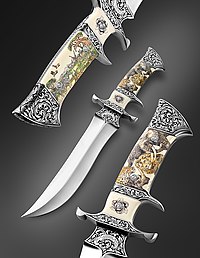Scrimshaw
Scrimshaw is the decorative and utilitarian objects created from the by-products of the whale hunt such as whalebone, baleen and walrus ivory by whalemen or sailors during the age of whaling. Historic scrimshaw was made before the final American whaling voyage in 1929. Defined by Dr. Stuart M. Frank. It is important to note that scrimshaw was made from non-saleable whale parts. The most valuable whale product was sperm whale oil that provided the brightest, cleanest source for interior lighting. The industry peaked in 1850. The discovery of plentiful oil in Pennsylvania in1859 and the expansion of the rail system began the long decline of the whaling industry. The creation of classic scrimshaw mirrored the vagaries of the whaling industry. The bulk of American scrimshaw was produced from around 1818 through the end of that century. Without provenance dating utilitarian scrimshaw is difficult. Most pieces are undated. There are some design characteristics of early canes and corset busks that give age hints, but the rest are inconclusive. Pictorial scrimshaw is different. Many images found on scrimshaw were copied or transferred from dated printed sources like magazines, newspapers and pulp publications. Other clues for dating are fashion or costume design, patriotic motifs, stars on American flags and vessel names.
The first American master of pictorial scrimshaw was Edward Burdett of Nantucket who went to sea in 1818 and was lost during a hunt in 1833. His contemporary Frederick Myrick, also from Nantucket, was active 1828-1829. These are among the earliest known American scrimshanders.
Information taken from an unpublished manuscript by the contributor

Scrimshaw is scrollwork, engravings, and carvings done in bone or ivory. Typically it refers to the artwork created by whalers, engraved on the byproducts of whales, such as bones or cartilage. It is most commonly made out of the bones and teeth of sperm whales, the baleen of other whales, and the tusks of walruses.
It takes the form of elaborate engravings in the form of pictures and lettering on the surface of the bone or tooth, with the engraving highlighted using a pigment, or, less often, small sculptures made from the same material. However, the latter really fall into the categories of ivory carving, for all carved teeth and tusks, or bone carving. The making of scrimshaw probably began on whaling ships in the late 18th century and survived until the ban on commercial whaling. The practice survives as a hobby and as a trade for commercial artisans. A maker of scrimshaw is known as a scrimshander.[1] The word first appeared in the logbook of the brig By Chance in 1826,[2] but the etymology is uncertain.[3]
History and materials
[edit]




Scrimshaw developed from the practice of sailors on whaling ships creating common tools, where the byproducts of whales were readily available. The term originally referred to the making of these tools, only later referring to works of art created by whalers in their spare time. Whale bone was ideally suited for the task, as it is easy to work and was plentiful.
The widespread carving of scrimshaw was enabled when the 1815 publication of the journal of U.S. Navy Captain David Porter disclosed both the market and the source of the whale teeth, causing a surplus of whale teeth that greatly diminished their value and made them available as a material for ordinary seamen.[4] Around this time is the earliest authenticated pictorial piece of sperm whale scrimshaw (1817). The tooth was inscribed: "This is the tooth of a sperm whale that was caught near the Galápagos Islands by the crew of the ship Adam [of London], and made 100 barrels of oil in the year 1817."[5]
Other sea animal ivories were used as alternatives to the rarer whale teeth. Walrus tusks, for example, may have been acquired in trade from indigenous walrus hunters.
Scrimshaw was a leisure activity for creative whalers. Life aboard a whaling ship often included long stretches of time between whale sightings, which gave those onboard a great deal of free time for creative pursuits.
Early scrimshaw was done with sailing needles or other sharp implements, and the movement of the ship, as well as the skill of the artist, produced drawings of varying levels of detail and artistry. Typically, readily available pigments onboard a whaleship like candle black, soot, or tobacco juice were used to bring the etched design into view. Ink, while used in some cases, was a more expensive and rarer option for this purpose. Many surviving examples of scrimshaw are unsigned, and a great many of the pieces are anonymous.
Today's artists use finer tools in various sizes, mostly borrowed from the dental industry. Some scrimshanders ink their work with more than one color, and restrained polychromed examples of this art are now popular.
Originating in an era when sperm whales were plentiful, only to be hunted to near collapse, scrimshaw is no longer an artform utilizing an easily renewable animal resource, but one that is susceptible to contraband. The Endangered Species Act and international conventions restricted the harvest and sale of ivory in an effort to bolster populations of ivory-bearing animals.
- Though there are sources of ivory that are sanctioned and legal, poachers in Africa and other continents where elephants are an endangered species still kill for their ivory. Elephant ivory has been regulated since 1976 by the Convention on International Trade in Endangered Species and selling African ivory has been prohibited since 1989.
- 19th and 20th century scrimshaw crafted before 1989 (elephant) or before 1973 (sperm whale ivory, walrus ivory etc.) is legal. It is prohibited after those years for commercial import in the U.S. under the Marine Mammal Protection Act.
- Walrus tusks bearing the Alaska State walrus ivory registration tag, and post-law walrus ivory that has been carved or scrimshawed by an indigenous Alaskan, is legal.
- Ancient ivory, such as 10,000- to 40,000-year-old mammoth or fossilized walrus ivory, is unrestricted in its sale or possession under federal law.
Scrimshanders and collectors acquire legal whale teeth and marine tusks through estate sales, auctions and antique dealers. To avoid illegal ivory, collectors and artists check provenance and deal only with established and reputable dealers. Scrimshaw that is found to have been illegally sourced may be seized by customs officials worldwide, dramatically loses value and is very hard to re-sell, as the limited channels through which collectible scrimshaw passes serves as a check on unscrupulous persons. As with any other fine art form, it is possible for experienced museums, auction houses or other experts to detect a fake.
Scrimshaw can also be practical tools that are hand carved by the scrimshander. They carved useful tools such as the jagging wheel. which is a multi-purpose tool used to pierce and trim a pie crust. Corset busks were carved from bone or ivory.
Care and preservation
[edit]Ivory is a fragile medium; many 19th-century pieces were preserved because they were kept in a barrel of oil on board ship. Gary Kiracofe, a scrimshander in Nantucket, Massachusetts, advises collectors that if a piece looks dry, one should fill the center of the tooth with unscented baby oil and allow it to remain until as much oil as possible is soaked into the microscopic pores of the ivory.[citation needed] Clear paste wax or high-end car wax will seal the surface after oiling. Bone items are even more fragile (more fibrous and porous) and may be treated the same way: with a light clear mineral oil. Organic oils are inadvisable, as they will eventually hasten discoloration, as on old piano keys subjected to the natural oils in one's hands.
Professional conservators of art and historic artifacts generally recommend against applying any type of dressing (like oil or wax) to organic objects such as whale ivory. Sensible choices regarding storage and display preserve whale ivory best: keep out of direct sunlight, handle with cotton gloves or freshly washed hands, and avoid keeping in places with shifting humidity and temperature. Coating organic objects can induce eventual cracking.
Design
[edit]Whale teeth and bones were a highly variable medium, used to produce both practical pieces, such as hand tools, toys and kitchen utensils, and highly decorative pieces, which were purely ornamental. The designs on the pieces varied greatly as well, though they often had whaling scenes on them. For example, Herman Melville, in Moby-Dick, refers to "lively sketches of whales and whaling-scenes, graven by the fishermen themselves on Sperm Whale-teeth, or ladies' busks wrought out of the Right Whale-bone, and other skrimshander articles".[6] Most engravings were adapted from books and papers.[citation needed]
Collections
[edit]A significant amount of the original scrimshaw created by whalers is currently held by museums.[citation needed] Museums with significant collections include:
- The Hull Maritime Museum in Kingston upon Hull, England
- [New Bedford Whaling Museum]] in [[New Bedford, Massachusetts]which includes the Kendall Whaling Museum Collection is the largest scrimshaw collection in the world.
- The Mystic Seaport Museum in Mystic, Connecticut
- The Scott Polar Research Institute in Cambridge, England[7]
- The Scrimshaw Museum at the Peter Café Sport in Horta on the island of Faial in the Azores
- The Nantucket Whaling Museum
- The Mariners' Museum in Newport News, Virginia
Other images of scrimshaw can be found at:
- The Museum of New Zealand Te Papa Tongarewa
- Ripley's Museum Niagara Falls – Scrimshaw piano key art
- Ripley's Museum Baltimore – Scrimshaw piano key art
- DaVinci exhibit – world travelling exhibit – Scrimshaw piano key art
- Detail on a piece in the Smithsonian Museum collection
- Sperm whale jawbone and teeth in the collection of the Scrimshaw Museum in Horta, Azores
- Detail on a piece in the Horta Scrimshaw Museum
- Scrimshaw cribbage board at The Mariners' Museum
- A small collection of scrimshaw, Smithsonian Scrimshaw Collection
Modern scrimshaw
[edit]
While scrimshaw artists rarely use whale bone anymore, it is still employed by a few. Common modern materials are micarta, ivory (elephant, fossil, walrus), hippo tusk, warthog ivory, buffalo horn, giraffe bone, mother of pearl, and camel bone. Modern scrimshaw typically retains the nautical themes of historical scrimshaw, but can also extend well beyond the traditional motifs.
Contemporary trade and carving techniques have led to more advanced, but fewer unique scrimshaw carvings. Collectors are advised to be aware of fakes.[8]
See also
[edit]- Chip work – glassware, engraved in a similar manner
- Bone carving
References
[edit]Notes
[edit]- ^ "scrimshander". Merriam-Webster.com. 2015. Archived from the original on 2007-09-30. Retrieved 2015-08-26.
- ^ Logbook of the brig By Chance, held at the New Bedford Whaling Museum (call number KWM #35A, Reel 3)
- ^ Morris, Evan (April 19, 2010). "Scrimshaw, A long time to be gone". The Word Detective. Retrieved 2015-08-26. And see Stephen Goranson's 2009 post to the American Dialect Society, "scrimshaw: proposed etymology".
- ^ Wertkin, Gerard C. (2004). Encyclopedia of American Folk Art. Routledge. p. 530. ISBN 978-1-135-95615-8.
- ^ Perrin, William F.; Wursig, Bernd; Thewissen, J.G.M. 'Hans', eds. (2009). Encyclopedia of Marine Mammals. Academic Press. p. 995. ISBN 978-0-08-091993-5.
- ^ Melville, Herman. "57: Of Whales in Paint; in Teeth; in Wood; in Sheet-Iron; in Stone; in Mountains; in Stars". Moby Dick; or, The Whale. Retrieved 2015-08-26 – via American Literature, Classic Books and Short Stories.
- ^ "Scrimshaw Collection at the Scott Polar Research Institute". University of Cambridge. Retrieved 2015-08-26.
- ^ Ronald C. Reece, PhD, "Ron's Ivory Coast"
Bibliography: Ashley, Clifford W. The Yankee Whaler. Boston, Houghton Mifflin Company, 1926. (scrim Pp. 111-116) Barnes, Clare, Jr., John F. Kennedy Scrimshaw Collector. Boston: Little, Brown and Company, 1969. Bowen, Abel. The Naval Monument. Boston. 1816, 1837. Carpenter, Charles H. Jr. and Mary Grace. The Decorative Arts and Crafts of Nantucket. N.Y. Dodd, Mead & Company, 1987. Dietrich, H. Richard III and Rebuck, Deborah M. In Pursuit of History. New Haven. Yale University Press. 2019, p. 282 Dike, Catherine. Canes in the United States. Illustrated Mementoes of American History 1607-1953. Ladue, MO. 1994. Flayderman, Norman. Scrimshaw & Scrimshanders. 1972. Frank, Stuart M. Biographical Dictionary of Scrimshaw Artists. 2018. Frank, Stuart M. Dictionary of Scrimshaw Artists. 1991. Frank, Stuart M. Ingenious Contrivances. 2012. Frank, Stuart M. More Scrimshaw Artists. 1998. Frank, Stuart M. Scrimshaw and Provenance. A Third Dictionary of Scrimshaw Artists 2013. Frank, Stuart M. Scrimshaw on Nantucket. The Collection of the Nantucket Historical Association. Nantucket, Ma. Nantucket Historical Association. 2019. Hegarty, Reginald B. Addendum to “Starbuck” and “Whaling Masters”. 1964. Hegarty, Reginald B. Returns of Whaling Vessels Sailing from American Ports 1876-1928. New Bedford, The Old Dartmouth Historical Society and Whaling Museum.1959. Hellman, Nina. Through the Eyes of a Collector. The Scrimshaw Collection of Thomas Mittler. n.p. Charlotte Mittler, 2015. Henderson, J. Welles and Carlisle, Rodney P. Jack Tarr. A Sailor’s Life 1750-1910. Woodbridge, Suffolk, U.K. Antique Collectors’ Club, Ltd. 1999. Lund, Judith N., Josephson, Elizabeth A., Reeves, Randall R., Smith, Tim D. American Offshore Whaling Voyages 1667-1927. 2 Vols. New Bedford, Old Dartmouth Historical Society, 2010. Malley, Richard C. Graven by the fishermen themselves Scrimshaw in Mystic Seaport Museum. 1983. (pp.70-73 Naval Monument Engraver) McManus, Michael. A Treasury of American Scrimshaw. 1997. Melville, Herman. Moby Dick or the Whale. N.Y. Random House, 1930 Meyer, Charles R. Whaling and the Art of Scrimshaw. 1976. N.Y.: David McKay Company, Inc. 1976 New Bedford and Old Dartmouth: A Portrait of a Region’s Past. New Bedford, Old Dartmouth Historical Association, 1976. Ridley, Donald E. and West, Janet. Frederick Myrick of Nantucket: Physical Characteristics of the Scrimshaw. 2000. Ridley, Donald E. and Frank, Stuart M. Frederick Myrick of Nantucket Scrimshaw Catalog Raisonne. 2000. Snyder, Jeffrey B. Canes From the Seventeenth Century to the Twentieth Century. Atgen, PA. 1993. Stackpole, Edouard A. Scrimshaw at Mystic Seaport. Mystic Ct., The Marine Historical Association. Pub. 33, 2nd ed. 1966. Starbuck, Alexander. History of the American Whale Fishery. 1989 ed. Webster, F.W., ed. Shipbuilding Cyclopedia. 1920.
Monographs and Articles Basseches, Joshua and Frank, Stuart M. Edward Burdett, 1805-1833 America’s First Master Scrimshaw Artist. 1991. Chang, Jack H.T. and Brust, James S. Imprint Journal of the American Historical Print Collectors Society, Vol. 36, No. 2 Autumn 2011 pp.9-11. “Ladies Fashion Plates and Other Illustrations Used for Scrimshaw” Huster, H. Harrison. “Scrimshaw: one part whalebone, two pats nostalgia”. The Magazine Antiques. August 1961. Pp. 122-125. Malloy, Mary. Tales from a “Skillful Hand”: Three teeth and Documentation by Jonathan Blaney Walton. The Scrimshaw Observer. Vol. 3, No. 3., Fall 2019. Pp. 2-5. Vardeman, Paul. “2000 Pieces of Scrimshaw? The Collection of Meylert Armstrong”. The Scrimshaw Observer. Vol 2., No. 2., Spring 2018. Pp. 3-4. Wilson, Claggett. Scrimshaw, The Whalman’s Art. The Magazine Antiques. November 1944. Pp. 278-281.
- Magazine Antiques Scrimshaw Articles:
June 1922 Pp. 260-262. Oct. 1936 Pp. 153-155 Nov. 1944. Pp. 278-281 July 1954. Pp. 47-49
New York Times Articles: April 25, 1955, pp. 14 “Greenwich Home Clings to Sea Art” Oct. 2, 1963, Pp. 44, Rita Reif, “Auction’s Drama Starts with Weeks of Backstage Work”.
Further reading
[edit]- Stevens, Jim (2008). Scrimshaw Techniques, History, Gallery, Equipment, Types of Ivory, Alternative Materials, Cutting, Sanding, Polishing, Creating Images, Inlays and Basing, Scrimshaw Techniques and Inking, Pub: Schiffer Publishing, ISBN 978-0-7643-2831-2
- Stevens, Jim (2008). Advanced Scrimshaw Techniques, Types of Ivory, Alternative Materials, Color Techniques, Power Scrimshaw, Carving, Imitations and Fakes, Repair, Conservation, Restoration, Glossary, Pub: Schiffer Publishing, ISBN 978-0-7643-3017-9
- Stevens, Jim (2010). Powder Horns: Fabrication & Decoration, Powder horn working, shaping, decorating, and finishing techniques. Historic and modern tools illustrate inlays, engrailing, and how to scrimshaw powder horns. Pub: Schiffer Publishing, ISBN 978-0-7643-3017-9
- Halat, Eva (2006). Contemporary Scrimshaw. Verlag Angelika Hörnig. ISBN 3-9808743-8-9.
External links
[edit]- Nantucket Historical Association Artifacts Online database
- Whaling depicted in scrimshaw and the art in ship logbooks
Bibliography: Ashley, Clifford W. The Yankee Whaler. Boston, Houghton Mifflin Company, 1926. (scrim Pp. 111-116) Barnes, Clare, Jr., John F. Kennedy Scrimshaw Collector. Boston: Little, Brown and Company, 1969. Bowen, Abel. The Naval Monument. Boston. 1816, 1837. Carpenter, Charles H. Jr. and Mary Grace. The Decorative Arts and Crafts of Nantucket. N.Y. Dodd, Mead & Company, 1987. Dietrich, H. Richard III and Rebuck, Deborah M. In Pursuit of History. New Haven. Yale University Press. 2019, p. 282 Dike, Catherine. Canes in the United States. Illustrated Mementoes of American History 1607-1953. Ladue, MO. 1994. Flayderman, Norman. Scrimshaw & Scrimshanders. 1972. Frank, Stuart M. Biographical Dictionary of Scrimshaw Artists. 2018. Frank, Stuart M. Dictionary of Scrimshaw Artists. 1991. Frank, Stuart M. Ingenious Contrivances. 2012. Frank, Stuart M. More Scrimshaw Artists. 1998. Frank, Stuart M. Scrimshaw and Provenance. A Third Dictionary of Scrimshaw Artists 2013. Frank, Stuart M. Scrimshaw on Nantucket. The Collection of the Nantucket Historical Association. Nantucket, Ma. Nantucket Historical Association. 2019. Hegarty, Reginald B. Addendum to “Starbuck” and “Whaling Masters”. 1964. Hegarty, Reginald B. Returns of Whaling Vessels Sailing from American Ports 1876-1928. New Bedford, The Old Dartmouth Historical Society and Whaling Museum.1959. Hellman, Nina. Through the Eyes of a Collector. The Scrimshaw Collection of Thomas Mittler. n.p. Charlotte Mittler, 2015. Henderson, J. Welles and Carlisle, Rodney P. Jack Tarr. A Sailor’s Life 1750-1910. Woodbridge, Suffolk, U.K. Antique Collectors’ Club, Ltd. 1999. Lund, Judith N., Josephson, Elizabeth A., Reeves, Randall R., Smith, Tim D. American Offshore Whaling Voyages 1667-1927. 2 Vols. New Bedford, Old Dartmouth Historical Society, 2010. Malley, Richard C. Graven by the fishermen themselves Scrimshaw in Mystic Seaport Museum. 1983. (pp.70-73 Naval Monument Engraver) McManus, Michael. A Treasury of American Scrimshaw. 1997. Melville, Herman. Moby Dick or the Whale. N.Y. Random House, 1930 Meyer, Charles R. Whaling and the Art of Scrimshaw. 1976. N.Y.: David McKay Company, Inc. 1976 New Bedford and Old Dartmouth: A Portrait of a Region’s Past. New Bedford, Old Dartmouth Historical Association, 1976. Ridley, Donald E. and West, Janet. Frederick Myrick of Nantucket: Physical Characteristics of the Scrimshaw. 2000. Ridley, Donald E. and Frank, Stuart M. Frederick Myrick of Nantucket Scrimshaw Catalog Raisonne. 2000. Snyder, Jeffrey B. Canes From the Seventeenth Century to the Twentieth Century. Atgen, PA. 1993. Stackpole, Edouard A. Scrimshaw at Mystic Seaport. Mystic Ct., The Marine Historical Association. Pub. 33, 2nd ed. 1966. Starbuck, Alexander. History of the American Whale Fishery. 1989 ed. Webster, F.W., ed. Shipbuilding Cyclopedia. 1920.
Monographs and Articles Basseches, Joshua and Frank, Stuart M. Edward Burdett, 1805-1833 America’s First Master Scrimshaw Artist. 1991. Chang, Jack H.T. and Brust, James S. Imprint Journal of the American Historical Print Collectors Society, Vol. 36, No. 2 Autumn 2011 pp.9-11. “Ladies Fashion Plates and Other Illustrations Used for Scrimshaw” Huster, H. Harrison. “Scrimshaw: one part whalebone, two pats nostalgia”. The Magazine Antiques. August 1961. Pp. 122-125. Malloy, Mary. Tales from a “Skillful Hand”: Three teeth and Documentation by Jonathan Blaney Walton. The Scrimshaw Observer. Vol. 3, No. 3., Fall 2019. Pp. 2-5. Vardeman, Paul. “2000 Pieces of Scrimshaw? The Collection of Meylert Armstrong”. The Scrimshaw Observer. Vol 2., No. 2., Spring 2018. Pp. 3-4. Wilson, Claggett. Scrimshaw, The Whalman’s Art. The Magazine Antiques. November 1944. Pp. 278-281.
- Magazine Antiques Scrimshaw Articles:
June 1922 Pp. 260-262. Oct. 1936 Pp. 153-155 Nov. 1944. Pp. 278-281 July 1954. Pp. 47-49
New York Times Articles: April 25, 1955, pp. 14 “Greenwich Home Clings to Sea Art” Oct. 2, 1963, Pp. 44, Rita Reif, “Auction’s Drama Starts with Weeks of Backstage Work”.


 French
French Deutsch
Deutsch



